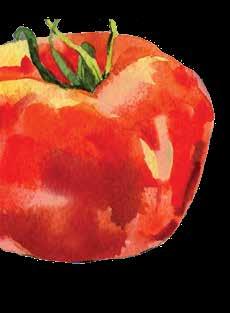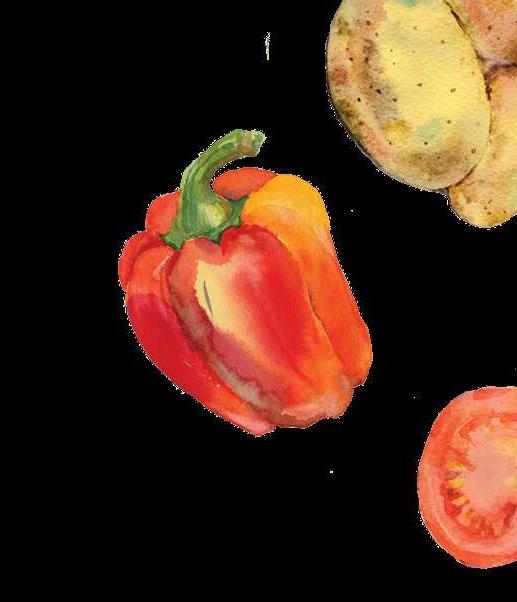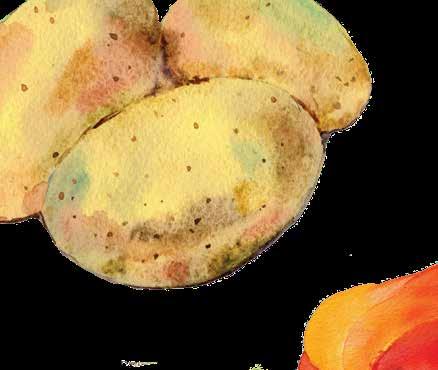
4 minute read
Nutrition
Hats off to Nightshades
WORDS KATE UNDERWOOD
You would not be alone in wondering how potatoes, eggplants, capsicums and tomatoes could possibly have anything in common.
However, this fascinating collective of unique, diverse and highly nutritious cousins are all proud members of the nightshade family. Scientifically known as Solanaceae, this brood of flowering plants are bound by the leafy green hats they wear when budding.
With up to 1000 edible and inedible living relatives, their distinctive leaf-hats are used as a protection mechanism with varying levels of toxicity to warn off insects as they grow. Chillies, goji berries, tamarillos and tomatillos are also noteworthy comrades of the nightshade clan, along with the extremely poisonous ‘belladonna’, an infamous weed historically used to kill enemies and as the poison of choice in Shakespeare’s Romeo and Juliet.

With origins in South America and grown widely across Europe, for years nightshades were left untouched and unconsumed, based on a fear and misconception that they were all tremendously deadly vegetables. This is mostly thanks to solanine, the highly toxic substance responsible for the bitter-taste. This ‘steroidal alkaloid saponin’ is present in highest amounts in the toxic leaves and stems of potatoes, with less presence in the leaves of other edible varieties. Green potatoes are particularly dangerous and can lead to serious neurological issues, due to a high solanine density that develops if they are exposed to excess sunlight.


All potato varieties, excluding kūmara, are part of the nightshade family. As everyone’s favourite tuber, the spud provides fibrous carbohydrates and a surprisingly generous dose of vitamin C. Potatoes often get unfairly ridiculed, but their nutrient levels are truly impressive. With a claim to nutrient fame involving dietary fibre, niacin, folate, pantothenic acid, thiamine, magnesium and particularly potassium. Containing more potassium than a banana, this powerful mineral helps strengthen bones, relieve stress and maintain strong function throughout the body.
Tomatoes are another formidable source of both vitamin C and A, potassium and various phytonutrients. Their red colour is thanks to the powerful carotenoid—lycopene—an antioxidant that helps prevent free radical cell damage and assists across the spectrum from heart to bone to eye health. Their versatility in form and application knows no bounds. Capsicums also provide a great source of vitamin C, along with vitamin B6 and folate—all of which help to absorb iron.
Eggplants are often dubbed a ‘brain food’ and heroed for their glossy, taut purple skin, their uniquely bitter taste and a spongy texture that soaks up flavour and shines when salt, acid or umami are present. Growing in a similar vein to tomatoes, they hang from the plant vines and are laden with important phytonutrients, including phenolic compounds and flavonoids including nasunin—a potent antioxidant that helps protect brain cell membranes from being damaged.
When it comes to including these nutrient dense nightshades in our diets, the reward far outweighs the risk. Funnily enough, nightshades also exist beyond the vegetable drawer and through into your pantry, with herbs and spices including paprika, chilli and cayenne pepper and condiments such as hot sauce, tomato sauce and salsa all deriving from nightshade vegetables and considered part of the family.
The link between arthritis and nightshades has been well-debated, though there is limited scientific evidence to suggest that nightshades actually flare up or further exacerbate the symptoms of arthritis. It’s true that some individuals may experience an intolerance, which can manifest in various ways, from bloating to nausea, to skin conditions including rashes, itchy eyes or

hives. This is due to a sensitivity to solanine, which is ‘thought’ to aggravate or inflame, although as a collective they are not inherently inflammatory. It’s also been suggested that cooking your nightshades can help reduce the solanine content by up to 50%. If you are at all concerned, always seek advice, and simply observing how your body feels after eating certain foods can be the most powerful and least glamorous way to gauge how you react to a particular ingredient.

For such an assorted, nutritive and rather peculiar family unit, their inclusion in one’s culinary world should be enthusiastically embraced. Experiment with a new technique, see how many ‘nightshades’ you can fit into one recipe (hint: Greek eggplant stew) and continue to unveil all the health-giving shades you possibly can while they are at their best and most delicious this summer season.
Kate Underwood
Kate is a freelance food writer and communications specialist for Eat New Zealand. With a background in human nutrition, she is on the executive committee of Food Writers New Zealand and was named Emerging Food Communicator at the 2019 NZ Food Media Awards. Born and bred in Te Puke on kiwifruit, whitebait and avocados, she spends her days celebrating, grammin’ and writing about great food and the glorious humans behind it. Find her on @relishthememory and @eat.newzealand on Instagram.

GINCREDIBLE OKTOBERFEST

WE ARE THE MAKERS
The event specialists who have a passion for creating memorable experiences
makeit@the-makers.co.nz wearethemakers.co.nz
NIGHT OWL CINEMA











